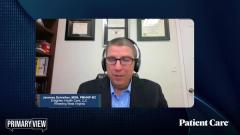
Treatment Switch for MDD
Greg Mattingly, MD, and Jeremey Schreiber, MSN, PMHNP-BC, discuss the typical strategies for switching therapies for major depressive disorder (MDD).
Episodes in this series

Greg Mattingly, MD: Let me ask a question, and this is a hot button [topic] for me. I’ve written articles about switching strategies. How do you switch somebody’s antidepressant? When you talk to somebody about a switch, what are your strategies about encouraging optimism? When you’re switching and you’ve not done well, it’s easy to feel like nothing’s going to work. How do you approach that with your patient and what kind of strategy do you have for switching?
Jeremy Schreiber, MSN, PMHNP-BC: I think that’s a great question because we don’t want our patients to feel like guinea pigs. “We’ll just try this. We’ll try that.”We’re not throwing a noodle at a wall to see what sticks. Ideally, what we’re trying to do is tailor treatment for our patients. When I’m thinking about switching, I think about switching when my patients are having a side effect to their medication. That’s one area [I consider]. If someone has no improvement to their medication whatsoever, that’s when I may think about switching or if patients have a side effect to a medication. If I have a patient that has some improvement to a medication, I generally look much more at combining or adjuncting or doing something of that nature so that way I don’t lose the benefit that I got from their initial agent. For instance, let’s say I have someone on, we’ll call it SSRI [selective serotonin reuptake inhibitor] number 1. I think an SSRI is going to be the best kind of a medication for this particular patient and maybe they’re not doing as well, and they only got somewhat better or whatever. And I’m going to move to SSRI number 2. There’s still SSRI-type medications and I don’t necessarily know that switching from one SSRI to another SSRI to another SSRI is great practice. I oftentimes will look at alternatives. At this point, if I have decided to switch [and] someone has a side effect, I’m going to switch much faster. That’s a “feel free to use another agent in the same class” thing in my mind. Whereas if someone has, what I would call lack of response and I’ve tried the medicine but it’s just not getting me there, at that point, I’m going to look at changing potentially to another class. I will oftentimes talk to my patients about, “This is what we thought was going to happen with this drug. These are the things that I really want to treat with this drug.”Maybe it’s energy and motivation. I may use a more stimulating kind of a medication and say, “Look, the chances that you may get a little bit of energy from this drug are very high. If it’s keeping you up at night, let me know.”If someone has more of an insomnia, I may use an agent that has a little bit more sedative properties. It really comes down to tailoring that agent that I’m switching to for the patient. The other thing is [that], when I also look at switching, I don’t have a lot of discussions right now with my patients about rapidity of efficacy being much different from one agent to another agent. I’m very excited for the days when I can have those discussions with my patients as well. “Oh, I want to use this one because its onset of action is like this.” I can have that [discussion] every once in a while, now, but I cannot have it all the time now because a lot of our agents still take quite some time to work. So when I am making switches, I tend to tailor it to the patients. I don’t know if that’s exactly what you’re looking for, [or] if you’d like me to clarify that a little bit, Dr Mattingly?
Greg Mattingly, MD: I think it’s good. I’ll give 2 tips to the audience though. I’ve written articles about switching strategies. I did a study a few years ago where we videotaped patients in response to being interviewed and us talking to them. A variety of clinicians across the country. The word switch to a patient started a whole cascade of emotions. Unfortunately, switching your antidepressant started a cascade of worry, concern, [thinking] “Maybe nothing’s going to work? If this one’s going to work, maybe nothing’s going to help me. What if I get worse instead of better? I know when I forget it, I feel even worse than where I am, even though I’m not great?”Switching started a cascade of negative emotions in 85% of people. The word switch. We took the exact same patients and we used the word start.“I’m going to start you on a new treatment because I think you can feel better than this. I’m going to start you on a new treatment because I think you’re having side effects with this one that this other one won’t cause. I’m going to start you on this because I’ve had a patient just like you who’s done really well with it.” The emotion of the patient, 90% to 95% of the time, was hope. It was optimism. I now talk about starting strategies. “I’d like to start you on something new.”I may cross-taper in my start. I may pull one back as I slide the other one up. I talk about boosting, because the word boost also had a lot of positive impact with patients. “I want to boost your response because I think you’re still struggling with partial depression. Let’s boost you and get you better.”I start new treatments or I boost their treatment, and that’s my new words because words have power with our patients.
Jeremy Schreiber, MSN, PMHNP-BC: I really like that. I’m so glad that we’re doing this right now, simply for that among everything else. That’s beautiful. When I was a young man, I used to work as a lifeguard and they taught us that when children were running around the pool, that we don’t yell. You don’t blow the whistle and say don’t run. You blow the whistle, and you say walk. I think that your point about the words that we choose ultimately have a lot of power with our patients. I like that [word] boost and I like that [word] start. I like that.
Greg Mattingly, MD: You mentioned something, and I think it’s100% right and it ties in with this. [And] that’s patient satisfaction. Jeremy, how many patients have you [had that] said, “That last clinician just threw pills at me?”
Jeremy Schreiber, MSN, PMHNP-BC: Can I say 100%? Am I allowed to say that?
Greg Mattingly, MD: As you’re doing your intake and you’re doing your assessment, [the patient says]“That last doctor, that last nurse, that last PA, they just threw pills at me.”You’re sitting there thinking [that] I’m going to throw pills at you too. “It’s what we do.”The question is, how do you help a patient to feel like you’re not throwing pills at them? How do you help with that patient satisfaction? I call it prescribing with hope. I’ll give you my words and then maybe you can share your words. My words for the last 30 years, it’s just something I’ve found that sticks and it’s holistic to who I tend to be as a person, is when I talk to my patients, I say, “I’m going to listen to you, but you’re going to guide me and we’re going to stick together till we get you better.”The dynamics of that is, I’m still going to try new treatments. I’m going to start new treatments, but they’re guiding me. If I’m listening to them and they’re guiding me, who have I turned the power over to? I’m empowering the patient. I’m empowering the patient, but it also gets around [the issue that] if they’ve guided me, they can’t yell at me for trying a new medicine. They’re trying the medicine. I’m just here to be along with it and then we stick together. I think those patient-centric things about, how do you engage a patient and inspire hope, that’s the art of medicine. It’s the fun part of medicine, too.
Jeremy Schreiber, MSN, PMHNP-BC: I wholeheartedly agree. One of the things that I’ve done is I’ve eliminated the word compliance from my vocabulary because I don’t think that compliance does anything good. In essence that entails that patients submit to our will, they’re compliant with treatment. I think adherence is truly the way it goes. I think to your point as well with our patients, when they are bought in, when they are vested, when they are helping to guide treatment, these patients are also likely to be more adherent to the treatment. This yields good results.
Greg Mattingly, MD: 100%. It’s not the patient who’s failing, it’s our treatment that’s failing. Patients don’t fail. Sometimes our treatments don’t work, and we have to be with them to find the right treatment.
TRANSCRIPT EDITED FOR CLARITY
Newsletter
Enhance your clinical practice with the Patient Care newsletter, offering the latest evidence-based guidelines, diagnostic insights, and treatment strategies for primary care physicians.



























































































































































































































































































